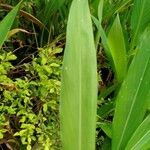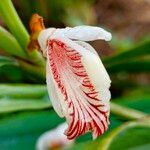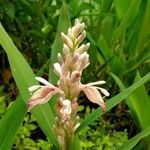Pseudostems to 1.3 m. Leaves sessile; ligule 8--15 mm, glabrous, apex obtuse; leaf blade linear-lanceolate, 20--32 × 2--3.5 cm or narrower, glabrous, base attenuate, margin with well-spaced, short bristles, apex acuminate and caudate-mucronate. Panicles less than 10 cm; rachis slightly velvety; proximal branches 3-or 4-flowered; bracteoles oblong, to 1.7 cm, membranous, apex obtuse. Pedicel ca. 3 mm. Calyx to 1.2 cm, split on 1 side, pubescent, apex 3-toothed. Corolla tube white, ca. 9 mm; lobes oblong, ca. 2.2 cm. Lateral staminodes red, subulate, ca. 3 mm, adnate to base of labellum. Labellum white with rose red and purple streaks, obovate, 2.7--3.5 × 1.5--2 cm, apex emarginate. Filament ca. 1.3 cm; anther 5--7 mm. Ovary 3--4 mm in diam., sericeous. Capsule red, globose. Fl. May. 2 n = 48*.
More
An evergreen herb with underground stems. It grows 1-1.3 m high. The leaves are narrowly sword shaped. They are 25 cm long by 5 cm wide. They are glossy dark green. They are prickly along the edge. The flowers are greenish white. They have a lip which is shell shaped. It has pointed erect bracts at the base of the flower. The bracts are red.
It is a subtropical and tropical plant. It needs regular moisture. It needs fertile, organically rich, well-drained soil. It needs some sunlight. It suits hardiness zones 8-11. In Yunnan.



